You're using an outdated browser. Please upgrade to a modern browser for the best experience.
Please note this is a comparison between Version 1 by Ruixia Chu and Version 2 by Vivi Li.
The booming electric vehicle industry continues to place higher requirements on power batteries related to economic-cost, power density and safety. The positive electrode materials play an important role in the energy storage performance of the battery. The nickel-rich NCM (LiNixCoyMnzO2 with x + y + z = 1) materials have received increasing attention due to their high energy density, which can satisfy the demand of commercial-grade power batteries. Prominently, single-crystal nickel-rich electrodes with s unique micron-scale single-crystal structure possess excellent electrochemical and mechanical performance, even when tested at high rates, high cut-off voltages and high temperatures.
- single-crystal
- nickel-rich NCM materials
- cathode
1. Introduction
Since the economic crisis in 2008, the global energy crisis and environmental pressures are becoming increasingly serious. In order to improve industrial competitiveness, and maintain sustainable economic and social development, the major automobile producing countries (e.g., the United States, Germany, Japan) have adopted the development of electric vehicles as a major strategy [1]. At present, the electric vehicle industry is one of the strategic emerging industries pursued by many countries [2][3][2,3]. After decades of development, ever-increasing requirements for energy storage devices have been identified, such as, higher energy density, better safety and longer service life, etc. [4][5][4,5]. However, realization of these goals mainly depends on the cathode material in the power batteries [6][7][8][6,7,8].
Ternary layered transition metal oxide, LiNixCoyMnzO2 (NCM, x + y + z = 1), was first proposed by J. R. Dahn’s group in 2001 [9]. According to the report, Li[NixCo1−2xMnx]O2 with x = 1/4 or 3/8 could be prepared by the ‘‘mixed hydroxide’’ method which combines a two-step calcination progress. The obtained samples have a layered α-NaFeO2-type structure, and deliver a stable capacity above 150 mAh g−1 at the current density of 40 mA g−1 in the voltage range of 2.5–4.4 V vs. Li. In particular, the capacity retention behavior of Li[Ni3/8Co1/4Mn1/4]O2 was close to that of LiCoO2 in the same potential window (2.5–4.2 V) and the thermal stability was better. As mentioned above, NCM is based on the hexagonal crystal system of the α-NaFeO2-type layered structure, which belongs to the R m space group and can be regarded as a solid solution of three compounds: LiCoO2, LiNiO2 and LiMnO2. The layered structure and compositional phase diagram of an NCM cathode are shown as Figure 1. the NCM cathode combines the advantages of LiCoO2, LiNiO2 and LiMnO2, exhibiting high operating voltage, large energy density and relatively good cycling performance [10][11][12][13][14][15][16][10,11,12,13,14,15,16]. In 2021, the Ministry of Industry and Information Technology of the People’s Republic of China officially released the “Lithium-ion Battery Industry Specification Conditions (2021)”, which states that the energy density of ternary materials-based batteries should not be lower than 210 Wh kg−1, the energy density of battery packs should not less than 150 Wh kg−1, and the specific capacity of ternary materials cathode should not less than 165 Ah kg−1. There has been some research investigating how to improve the stability, safety, and meanwhile reduce the cost of NCM material while ensuring its high energy density [15][17][18][15,17,18].
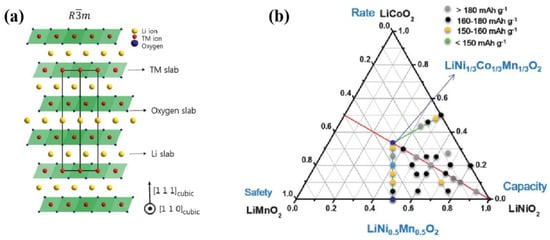
Figure 1. Illustration of the ordered layer structure and phase diagram of NCM materials: (a) the hexagonal crystal system layered structure; (b) NCM composition phase diagram of several typical Ni-Co-Mn ratios, reproduced from Ref. [15], Copyright 2008, The Royal Society of Chemistry.
It is well known that nickel, cobalt and manganese in NCM materials have obvious synergistic effects. Cobalt can stabilize the layered structure, improve electric conductivity, and thus promote the cycle and rate capability for NCM. However, excessive cobalt content leads to more serious economical and environmental problems due to its cost and toxic nature. Nickel can improve the volume energy density of the NCM, while ternary materials with high nickel content lead to cation mixing and cause various problems including capacity loss, structure deterioration and poor thermal stability. Manganese can reduce the costs and improve the safety and structural stability of the NCM. However, a higher manganese content leads to reduced electrochemical activity in the charging/discharging process, and lower specific capacity of the NCM [4][19][20][21][22][23][24][25][26][27][28][29][4,19,20,21,22,23,24,25,26,27,28,29]. For these reasons, numerous scholars have improved the electrochemical properties of NCM by adjusting the elemental ratios of Ni-Co-Mn in order to obtain ternary materials with better performance in all aspects. The relevant NCM materials that have been studied include LiNi1/3Co1/3Mn1/3O2 (NCM111) [30][31][32][33][34][35][30,31,32,33,34,35], LiNi0.4Co0.2Mn0.4O2 (NCM424) [30][31][32][33][34][30,31,32,33,34], LiNi0.5Co0.2Mn0.3O2 (NCM523) [36][37][38][39][40][41][36,37,38,39,40,41] and other NCM materials with non-stoichiometry ratios of Ni-Co-Mn elements [42][43][44][45][46][47][48][49][50][51][52][42,43,44,45,46,47,48,49,50,51,52], etc. In particular, the nickel-rich NCM materials LiNi0.6Co0.2Mn0.2O2 (NCM622) [52][53][54][55][56][57][58][59][60][61][52,53,54,55,56,57,58,59,60,61], LiNi0.8Co0.1Mn0.1O2 (NCM811) [7][62][63][64][65][66][67][68][69][70][71][7,62,63,64,65,66,67,68,69,70,71] and other NCM with more than 90% nickel content [69][72][73][74][75][76][77][78][69,72,73,74,75,76,77,78], even the cobalt-free ternary materials [79][80][81][82][83][84][85][86][87][88][89][90][91][79,80,81,82,83,84,85,86,87,88,89,90,91], have become increasingly popular active cathode materials because of the higher potential vs. Li, higher energy densities, less toxicity, and lower priced raw materials, which can better meet the needs of electric vehicles. Nevertheless, there still are many remaining challenges in the commercialization of NCM cathodes with high-nickel content (Ni ≥ 60%) including performance deterioration and potential safety concerns. The poor lithium storage and safety of nickel-rich NCM cathodes mainly originate from the following aspects [14][15][16][28][92][93][94][95][96][97][98][99][14,15,16,28,92,93,94,95,96,97,98,99]. (i) During the cycling, heavy Ni2+ and Li+ cation mixing and more vacancies accompanied by oxygen release occur at the stage of the deep delithiation, resulting in irreversible phases transformation from the original layered structure into the spinel-like phase or inactive rock-salt phase, thus leading to poor kinetics, structural stability, thermal stability and cycling performance. (ii) Predomination of the highly oxidized Ni4+ ions at the end of charge process leads to a list of issues including the dissolution of transition metal ions, electrolyte decomposition, undesired side interfacial reactions, and the formation of cathode solid electrolyte interfaces (cSEI), which result in low coulombic efficiencies and rapid capacity reduction. (iii) During the lithiation and delithiation process, large lattice volumetric change brings about stress accumulation inside nickel-rich NCM materials, which results in secondary particle microcracks along the grain boundaries, and thus induces further structural degradation and sustained capacity loss.
To address or alleviate the above issues and improve the electrochemical performance of nickel-rich NCM materials, some feasible strategies have been proposed. First, ionic doping is an effective method to stabilize the structure of a nickel-rich NCM electrode. The purpose of doping is to make the dopant ions enter the lattice, replace some of the ions in the raw lattice, stabilize the raw material structure and improve the cycling stability during the charging and discharging process [100][101][102][100,101,102]. In particular, about ten years ago, John B. Goodenough, and Arumugam Manthiram had conducted an in-depth study into the effects of element doping, cation ordering and lithium content on the conductivity and electrochemical characteristics of high-voltage spinel transition metal oxide cathode materials [26][27][26,27]. The relationship between the conductivity, phase transformation mechanisms and the content of Mn3+, and the degree of cation ordering were investigated. It was found that Mn3+ content and ordering of spinel were not critical to the phase transformation behavior but benefited the high rate capability. Studies of ionic doping in nickel-rich NCM materials include a multitude of dopants such as Mg [102][103][102,103], Al [4][102][104][105][4,102,104,105], Zr [106][107][108][106,107,108], Ti [44][109][110][111][44,109,110,111], Nb [112][113][112,113], Mo [114][115][114,115], Cr [116], F [117][118][119][120][117,118,119,120], B [76][121][122][76,121,122], etc. Proper doping can also boost the cycling performance of the conductivity and lithium ion migration rate of the NCM electrode [15][123][15,123]. In addition, the design of the concentration-gradient structured materials can effectively improve the rate and cycling performance [124][125][124,125]. Second, surface coating is considered an effective method to improve the capacity retention, rate capability, and thermal stability of an NCM cathode. With the surface coating, the cathode and electrolyte are mechanically separated, and the dissolution of transition metal ions and the interfacial side reaction between cathodes and liquid electrolytes are effectively suppressed, improving the cycling performance of the NCM materials. The surface coating can also reduce the collapse of the material structure during long charging and discharging processes, which is beneficial to the cycling and thermal stability of the NCM materials [15][16][28][92][93][94][95][126][127][15,16,28,92,93,94,95,126,127]. Various coating materials applied on the NCM cathode can be divided into the following categories, such as oxides (SiO2 [128][129][130][128,129,130], Al2O3 [131][132][133][134][135][131,132,133,134,135], ZrO2 [136][137][138][139][140][141][136,137,138,139,140,141], TiO2 [138][142][143][144][145][146][138,142,143,144,145,146], etc.), phosphates (AlPO4 [147][148][147,148], FePO4 [149][150][149,150], Ni3(PO4)2 [151], CaHPO4 [152], Mn3(PO4)2 [153][154][153,154], ZrP2O7 [155][156][155,156], etc.), Li-containing compounds (Li3PO4 [157][158][159][157,158,159], Li2ZrO3 [160][161][162][163][160,161,162,163], Li2TiO3 [160][164][165][160,164,165], Li1.5Al0.5Ge1.5(PO4)3 [166], etc.), electron conducting coatings (graphene or reduced graphene oxide (rGO) [167][168][169][170][171][167,168,169,170,171], permeable poly (3,4-ethylenedioxythiophene) (PEDOT) [172][173][172,173], polyaniline (PANI) [174][175][174,175], poly-pyrrole (PPy) [176][177][176,177], etc.), etc. Combining a concentration gradient and surface coating, the NCM materials with a core-shell structure represent the advantages of the high capacity and high thermal and mechanical stability [178][179][178,179]. Third, electrolyte optimization is another effective strategy toward improved performances. As mentioned earlier in the text, the cSEI film reconstruction occurs easily between the solid cathode and organic liquid electrolytes during the cycling, degrading the electrochemical properties of NCM cathodes, especially at high voltages. Different electrolyte additives have been considered to adapt to the high operating voltage of NMC, restrain undesired side reactions and stabilize the surface structure [18][30][46][68][126][180][18,30,46,68,126,180]. With the addition of LiBOB dopamine [181], metal-organic framework (MOF) [182], acetonitrile (AN) [183], vinylene carbonate (VC) [184], fluoroethylene carbonate (FEC) [185] or other tailoring electrolyte additives, the lithium-ion transference number has been effectively increased, the rate capability has been enhanced, and the cycling life has been prolonged [186][187][188][186,187,188]. Typically, the solid-state electrolyte also attracts much attention because of the higher safety and cycling stability compared with combustible organic electrolytes. The solid-state interface engineering strategy is a simple promising method for NCM batteries to meet the ever-increasing requirements of safe power vehicles [189][190][191][192][193][194][195][189,190,191,192,193,194,195].
Nevertheless, the research about NCM materials summarized above, whether on normal ternary materials or nickel-rich, nickel-ultra-rich or cobalt-free materials, mostly focuses on macro-size polycrystalline secondary spheres composed of nano-size primary grains with random orientations. The continuous growth and expansion of deep-rooted cracking along weak internal grain boundaries still cannot be thoroughly eliminated due to the ever-present anisotropic strain among the randomly oriented primary grains during the charge–discharge process. Although the increasing specific surface area improves the lithium ion conductivity, it aggravates the undesired side reactions between the cathode and electrolyte, increasing the degradation of capacity retention and further reducing the cycling stability. In addition, the internal kinetics of polycrystalline materials are more unstable and the stress distribution is more uneven, especially for nanoscale NCM materials with a higher Ni content or operating voltage (≥4.5 V), which makes the materials highly susceptible to structural collapse and capacity decay during prolonged cycling, largely reducing thermal stability and safety [36][67][94][196][197][36,67,94,196,197].
2. Synthesis
At present, various synthesis strategies have been developed, including co-precipitation combined with the multi-calcination method (solid-state method) [36][198][199][200][201][202][203][204][205][206][207][208][36,200,224,225,226,227,228,229,230,231,232,233], the molten salt assistant method [209][210][211][212][213][214][215][216][217][218][219][220][221][199,211,218,234,235,236,237,238,239,240,241,242,243] and the solvothermal method [222][223][224][225][244,245,246,247]. The main synthesis strategies of single-crystal nickel-rich NCM materials are shown in Figure 23.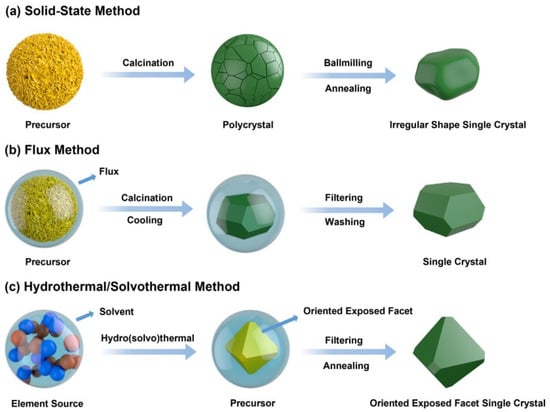
Figure 23. A schematic diagrams of the main synthesis strategies for single-crystal nickel-rich NCM materials, reproduced from Ref. [226]. Copyright 2021, Elsevier.
A schematic diagrams of the main synthesis strategies for single-crystal nickel-rich NCM materials, reproduced from Ref. [222]. Copyright 2021, Elsevier.
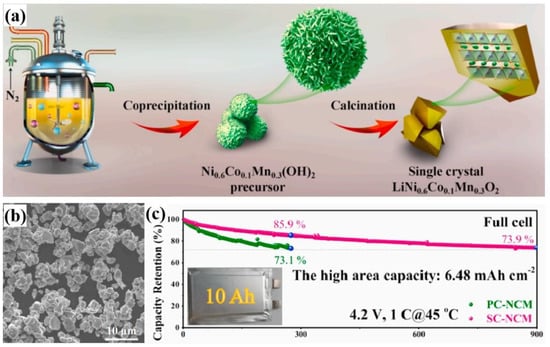
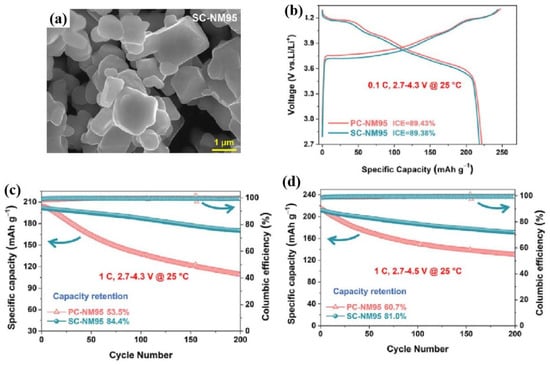
Figure 45. Research content reproduced from Ref. [215][237]: (a) SEM image of fresh SC-NM95 materials; (b) the first discharge/charge curves, and the cycling performance at difficult cut-off voltage of (c) 4.3 V and (d) 4.5 V of comparison between SC-NM95 and PC-NM95 materials, Copyright 2022, Elsevier.
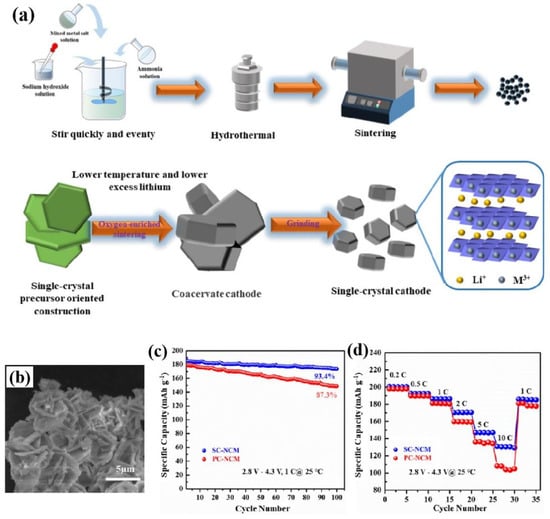
Table 1.
Electrochemical properties of single-crystal nickel-rich NCM materials synthesized via different strategies. (CR = Capacity Retention).
| Material Components | Synthesis Methods | Electrochemical Performance | Ref. |
|---|---|---|---|
| LiNi0.6Co0.1Mn0.3O2 (SC-NCM613) | One-step calcination method | CR of 73.9% after 900 cycles at 1 C, 45 °C, 2.75–4.2 V, pouch full cell | [227][248] |
| LiNi0.6Co0.2Mn0.2O2 (SC-NCM622) | One-step calcination method | CR of 82.6% after 3000 cycles at 1 C, 25 °C, 3.0–4.2 V, pouch full cell | [228][249] |
| Ce-doped Li[Ni0.9Co0.05Mn0.05]O2 (SC-Ce-NCM90) |
One-step calcination method with lower temperature | CR of 80.5% after 100 cycles at 0.5 C, 30 °C, 2.7–4.3 V, half cell | [229][250] |
| Li[Ni0.7Co0.15Mn0.15]O2 (SC-NCM70) | Calcination method | CR of 91% after 100 cycles at 0.5 C, 30 °C, 2.7–4.3 V, half cell | [208][233] |
| LiNi0.91Co0.06Mn0.03O2 (SNCM91) | Molten salt assistant method | initial discharge capacity of 203.8 mAh g−1 at 0.1 C, 3.0–4.3 V, half cell | [220][242] |
| LiNi0.92Co0.06Mn0.02O2 | Molten salt assistant method | CR of 86.3% after 300 cycles at 0.5 C, 25 °C, 2.7–4.2 V, pouch full cell | [213][235] |
| LiNi0.92Co0.06Mn0.01Al0.01O2 (NCMA) | Solid-phase sintering method | 221.4 mAh g−1 at 0.1 C, 3.0–4.3 V, CR of 94.9% after 100 cycles at 45 °C, half cell | [218][240] |
| LiNi0.95Mn0.05O2 (SC-NM95) | Molten salt assistant method | CR of 81% after 200 cycles at 1 C, 25 °C, 2.7–4.5 V, half cell | [215][237] |
| LiNi0.6Co0.2Mn0.2O2 (SC-NCM622) | Molten salt assistant method | 155.1 mAh g−1 at 1 C, CR of 94.3% after 240 cycles at 1 C, 25 °C, 2.8–4.3 V, half cell | [216][238] |
| LiNi0.8Co0.1Mn0.1O2 (SC-NCM811) | Hydrothermal method | 186.2 mAh g−1 at 1 C, CR of 93.4% after 100 cycles at 1 C, 25 °C, 2.8–4.3 V, half cell | [222][244] |
| LiNi0.8Co0.1Mn0.1O2 (SC-NCM811) | Solvothermal method | 226.9 mAh g−1 at 0.1 C, CR of 91.2% after 100 cycles at 1 C, 25 °C, 2.8–4.3 V, half cell | [223][245] |
| LiNi0.6Co0.2Mn0.2O2 (SC-NCM622) | Hydrothermal method | 184.2 mAh g−1 at 0.1 C, CR of 89.6% after 100 cycles at 1 C, 2.8–4.5 V, half cell | [224][246] |
